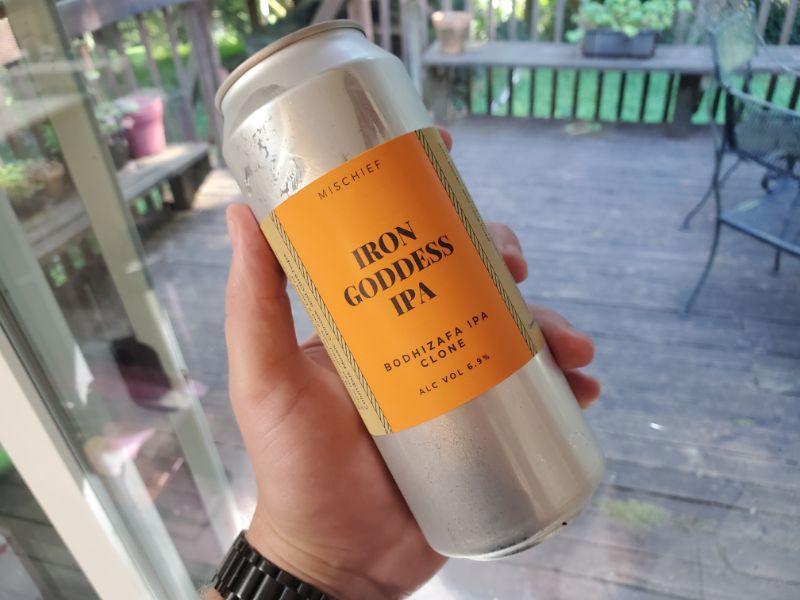Bodhizafa IPA Clone, a.k.a. Iron Goddess IPA
Originally Posted: August 29, 2020

Table of Contents
Quick Specs
- Est. OG = 1.060
- Est. FG = 1.010
- OG = 1.060
- FG = 1012
- ABV: 6.3%
- Taste Profile: Citrusy-hoppy and well-balanced with the malt, close to the real thing
- Time: 13 days (3 in primary, 7 on dry-hops, 3 clarifying)
- Yield: 1 corny keg
Intro
IPAs
Where I liked medium-bodied malty beers when I was younger, my taste buds have made a slow transition to liking roasty dark beers or hoppy beers.
Being among the hoppiest styles, IPAs are among my favorite types of beer. There’s so much variety within the IPA style, from the mellow and traditional British IPA to the hop-bombs of the PNW and the refreshing hazy NEIPA.
Northwest IPAs and Georgetown Brewing
The Pacific Northwest is known for its IPAs, and Bodhizafa IPA by Georgetown Brewing in Seattle has been at the top of my list for about a year now. It makes an appearance at most get-togethers and family dinners, so I decided I wanted to brew one to share with friends and family.
One neat thing about Georgetown Brewing is that they list all the ingredients for their beers on their website in a section called “For Beer Geeks”. I managed to find a recreation by another homebrewer for an 11-gallon batch and scaled it down to 6.5 – 7 gallons to fit my Grainfather. On a side note, I choose 6.5 – 7 because I round up for my water calculations for a trub-heavy recipe like this.
Time to Experiment
Around the time I first decided to brew this beer, I managed to get my hands on a bulk package of Lallemand Dry Voss Kveik. Its neutral (for a kveik) characteristics lend themselves to many a beer style, and with my DIY temperature control set-up I can ferment most beers in 2 – 3 days. Along with the 7-day dry-hop addition, this beer takes a total of 9 – 10 days before it’s ready for bottling or kegging.
This ended up being one quick and tasty IPA, and I’ve added it to my normal brewing rotation along with my oatmeal stout.
Ingredients
Malt
- 8.25 lbs. (8 lbs., 4 oz.) American 2-row Pale Malt (I like to use Great Western NW Pale)
- 4 1/8 lbs. (4 lbs., 2 oz.) Munich Light 10°L
- 2 3/8 lbs. (2 lbs. 6 oz.) Flaked oats (you can use “quick oats” from the grocery store, I think large cans of them are just over 2 lbs.)
- Total Grain Weight: 14.75 lbs.
Hops/Other
- 2 oz. Columbus @ 15 min.
- Yeast nutrient and Whirlfloc @ 15 min.
- 2 oz. Mosaic @ 10 min.
- 2 oz. Citra @ 10 min.
- 2 oz. Chinook @ 10 min.
- 2 oz. Mosaic @ 5 min.
- 2 oz. Citra @ 5 min.
- 2 oz. Mosaic @ 1 min.
- 2 oz. Citra @ 1 min.
- 2 oz. Mosaic & 2 oz. Citra dry-hop for 7 days
Yeast
Equipment
- Sanitizer
- Fermenter
- Airlock and stopper
- Brewing system of your choice (I use the Grainfather 30L)
- Hop spider (optional, but suggested)
Instructions
- Mash at 146°F (63°C) for 1 – 2 hours (original recipe suggests 120 min., but I’ve gotten full starch conversion at 1 hour).
- Boil for 60 minutes, following hop schedule.
- Chill, add yeast, and let beer go through primary fermentation (kveik yeast with temperature control can finish this in 2 – 3 days).
- Dry-hop for 7 days.

Variations
The second time I brewed this, I decided to make a lighter, more sessionable version to see if there would be much of a flavor difference. I also skipped the dry-hopping because I was short on time, and was also curious to see if anyone noticed.
Tips & Tricks
For hop trub-heavy beers, it’s good to use more water than you usually would. This is especially true if you use a Grainfather or similar all-in-one system. You’re bound to lose some wort to both hop trub and pipework; there will always be liquid lower in your kettle than your pump inlet.
Scaling Grain and Water
When I scale a beer recipe for my own set-up, I like to end up with slightly more beer than will fit in a Corny keg. This frees me from worrying about not being able to fill a keg all the way after losing wort to my Grainfather and beer to yeast trub after fermentation. Sometimes I’ll be left with ½ to 1 gallon of extra beer after kegging, so I save it in a 1-gallon carboy for bottle-conditioning or for blending experiments.
I normally scale beer recipes to 6.5 gallons (for purposes of water calculation), but for this one it’s better to scale to 7 gallons.







